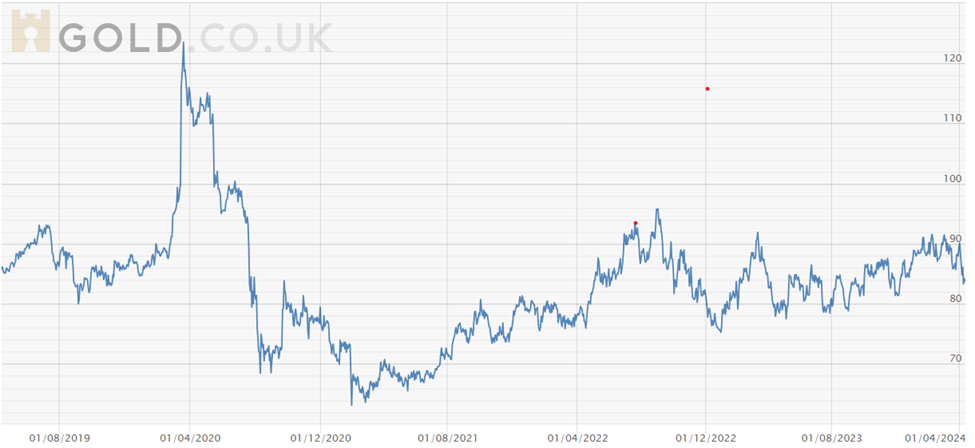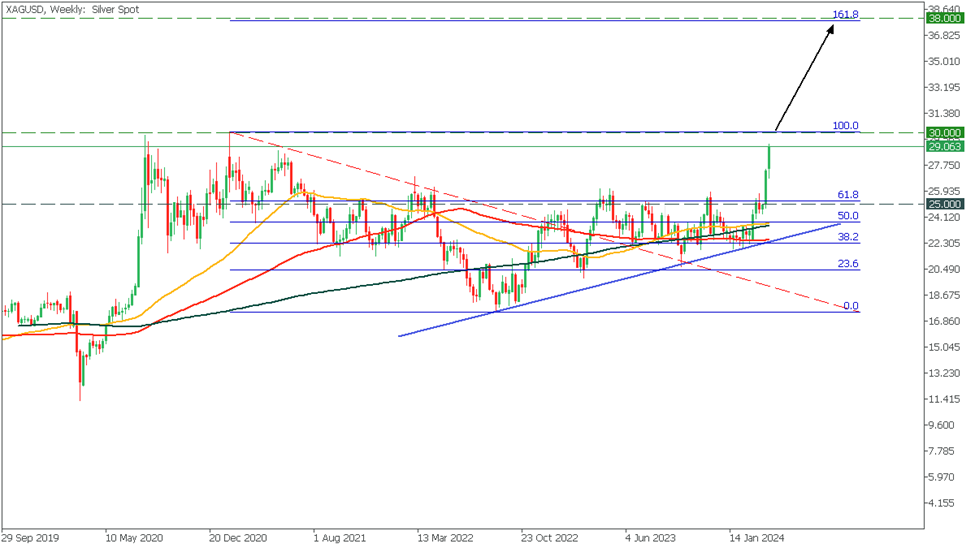The silver market is under the watchful eye of professional traders, and for good reason. 2024 silver is at the intersection of limited supply and growing demand. As industries increasingly rely on silver for its indispensable role in many applications, the tension between available supply and industrial necessity emphasizes silver's centrality. This year combines economic uncertainty in many countries, political factors, and geopolitical tensions, which has only spurred trader and investor interest in silver.
This article will look at silver from all angles to answer why there is so much talk about silver and whether it has such potential.
The Time of the Silver Shortage
The silver market is experiencing a unique phase in which limited supply is combined with growing demand, especially from industrial sectors. So, what is going on with the silver market, and what is the catalyst for change?
A surge in silver demand
The demand for silver is experiencing a significant surge due to its widespread use in multiple industrial sectors, such as renewable energy, electronics, and medicine. The unique physical properties of silver, including its electrical conductivity, make it an invaluable component in these industries. Global silver demand is projected to grow to 1.2 billion ounces in 2024, driven by increased industrial consumption, with the sector expected to reach a new annual high. In particular, key growth drivers have been the photovoltaic (PV) and automotive industries, where global PV installations and the use of silver in electronic components and battery charging infrastructure are driving silver consumption.
Limited mine production
Even with the opening of new mines in 2023 in strategically essential locations such as Mexico and Chile, silver production is expected to increase by only 5% to 873 million ounces. This increase, while significant, will not bridge the growing gap between supply and demand. The constrained growth is due to several factors, including the depletion of existing mines and the long lead times for new projects. In addition, global silver supply is forecast to grow by 3% to an eight-year high of 1.02 billion ounces in 2024, mainly due to a recovery in mine production. Geopolitical tensions
The silver mining industry is not immune to geopolitical tensions that further complicate the challenging silver mining process. For example, by-product silver production from base metal mines has declined due to public and governmental disputes, particularly in South America, which will lead to the closure of some mines in 2024.
Impact of Green Energy Transition and Technological Advancements
The transition to green energy and continuous technological advances drive the demand for silver in the 21st century. The role of silver in photovoltaics, which is crucial for solar energy systems, and its application in new technologies are significantly increasing the demand for silver. Industrial silver production is projected to grow at a CAGR of 4% to a record 690 million ounces in 2024, highlighting the metal's critical role in supporting sustainable energy solutions and technological innovation.
Given these factors, the silver market is experiencing a period of tight supply amidst rising demand. The interplay of limited production, geopolitical tensions, environmental regulations, and demand-driven sectors paints a complex picture of the future of silver supply and point to possible silver price increases.
The Detailed Impact on Silver
The dynamics of the US dollar and its subsequent impact on commodity prices are becoming increasingly important, especially for traders and investors focused on precious metals. Since its peak in 2022, the USD has shown a weakening trend, which is critical to understanding the trajectory of the commodity market. This trend reflects the broader context of monetary policy adjustments and economic indicators directly impacting commodity prices.
The US inflation rate as of April 2024 was 3.5%, up from the previous rate of 3.2%, indicating a slow but steady rise in prices across the U.S.. These inflationary pressures, combined with the Federal Reserve's monetary policy stance, directly impact commodity prices, including silver. J.P. Morgan's 2024 market outlook assumes a continuation of the central bank tightening cycle in the second half of the year, with the possibility of rate cuts beginning in the third quarter, which could impact the valuation of the U.S. dollar and, hence, silver prices.
The impact of the Fed's key rate: how can politics impact silver?
Several geopolitical events and conflicts could significantly influence the silver market. These include multipolarity with the growing influence of geopolitical states such as India, Saudi Arabia, Turkey, South Africa, and Brazil; reduced global supply chain risk due to countries encouraging domestic production over imports; heightened geopolitical tensions related to AI and maritime routes; and a global electoral supercycle with elections in countries representing 54% of the world's population and nearly 60% of global GDP.
Escalating trade tensions between the U.S. and China remains a critical factor that could lead to further financial disruption between these two largest economies. Such a scenario could significantly disrupt global financial markets, affecting the silver market as investors look for safe-haven assets in the face of uncertainty. Climate change and energy security are significant geopolitical risks that could indirectly affect the silver market.
The Gold/Silver ratio as a crucial indicator
The Gold-to-Silver Ratio, which measures the number of silver ounces needed to buy one ounce of gold, has historically been used to indicate the relative value of the two metals.
Over the past years, the gold/silver ratio has fluctuated between 75 and 95, a prolonged rise that has only been seen a few times. This prolonged period of high ratio indicates that gold has been significantly more expensive than silver, which has led to discussions of potential silver rallies similar to those seen after previous periods of high ratio.
For example, the historical trend of the gold/silver ratio and its current levels have led to predictions that silver could be one of the most profitable investments in the coming years. This is based on the expectation that the price of silver could rise significantly if the ratio returns to historical averages or if silver catches up with the trend in gold prices.
Source: Gold.Co.Uk, Gold: Silver Ratio
The April 2024 gold/silver ratio is 83.63, meaning that one ounce of gold is currently worth approximately 83.63 ounces. This ratio continues to increase, signaling a solid undervaluation of silver among investors. No doubt attention will shift to silver unambiguously. Such a high ratio indicates that gold appreciates against silver or, conversely, silver depreciates against gold.
Assuming the ratio reverts to its historical average, silver's price could rise relative to gold's. For investors and analysts who follow historical trends, a high gold-to-silver ratio might signal a buying opportunity for silver.
Different Silver Market Forecasts and Strategy
With a looming silver shortage and changing market dynamics, understanding possible paths and preparing for different outcomes is crucial. Experts agree that the outlook for silver is bullish. Several analysts predict that prices could reach or even exceed the $30 mark by the end of the year.
Bullish forecasts
Several reputable sources have presented their silver forecasts for 2024, painting a picture of metal on the cusp of significant price gains:
● InvestingHaven.com foresees silver reaching a bullish target between $34.70 and $48, emphasizing a significant potential upside depending on economic conditions.
● Robert Kiyosaki makes an exceptionally bullish prediction, suggesting silver could soar to $500 by the end of 2024, reflecting an extreme scenario.
● JPMorgan, Commerzbank (ETR:CBKG), and CitiGroup each predict silver prices to be around $30 in 2024, indicating a positive outlook based on economic and market trends.
● Heraeus Precious Metals provides a more cautious forecast, suggesting silver could be priced between $22 and $29, reflecting a range of outcomes based on differing market conditions.
● A Reuters survey reports a median prediction of $24.85, illustrating a consensus among traders and analysts on a modestly optimistic outlook.
● Capital Economics expects silver prices to average $27, citing solid industrial demand and limited supply growth as key drivers.
● BTCC, a leading cryptocurrency exchange, forecasts a wide range for silver, from $18 to $50, underscoring the high level of uncertainty and volatility in precious metals markets.
● Physical Gold predicts silver prices to reach around $27 per ounce, citing factors such as supply and demand dynamics, macroeconomic trends, and geopolitical events.
● Goldman Sachs had earlier forecasted silver to hit $29.50, aligning with the upper range of many predictions and highlighting expectations for solid performance.
● Gov Capital predicts silver could surpass $37, potentially reaching beyond $40 per ounce, indicating a bullish scenario driven by monetary policy and macroeconomic factors.
Strategy in times of silver scarcity
XAGUSD, Weekly Timeframe 
On the Weekly Timeframe, XAGUSD is showing solid gains, and the price is approaching the historical record at 30,000. The moving averages signal bullish sentiment, suggesting that the bullish trend may continue.
If the resistance at 30,000 is broken, the target will be 38,000, corresponding to 161.8 Fibonacci.
The anticipation of a silver shortage adds a layer of urgency for investors and the market. With global silver demand forecasted to reach 1.2 billion ounces in 2024 and supply struggling to keep pace, the potential for a tightening market is evident. This scenario, coupled with increasing demand from sectors critical to the energy transition, such as solar energy, places additional pressure on available silver supplies, heightening concerns over future availability and price impacts.
Key strategies for silver this year include increasing physical inventories, utilizing futures contracts for hedging purposes, and closely monitoring industrial demand indicators as a benchmark for timing market entry and exit.
Conclusion
The silver market will be particularly active in 2024. With dwindling supplies and surging demand from the technology and green energy sectors, silver is becoming a hot commodity. All of this could be an excellent opportunity for investors and traders. Production constraints and continued growth in industrial use mean that silver's value, and possibly its price, will skyrocket.
Moreover, the gold-to-silver ratio indicates that silver could be a bargain compared to gold right now, making it attractive for those looking to make a smart addition to their portfolio. Both seasoned investors or new comers need to keeping a close eye on the way these trends develop and acing market opportunities for significant gains..
***
Traders and investors should be aware of the key market milestones and the consequences for the future economy. Using FBS, traders can benefit from rising and falling markets. The company offers over five hundred fifty trading instruments to build trading strategies on.
Disclosure: FBS is an international brand present in over 150 countries. Independent companies united by the FBS brand are devoted to their clients and offer them opportunities to trade Margin FX and CFDs. FBS Markets Inc. – Belize FSC 000102/6, Tradestone Ltd. – CySEC license number 331/17, Intelligent Financial Markets Pty Ltd – ASIC License number 426359.
